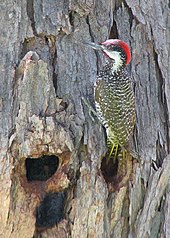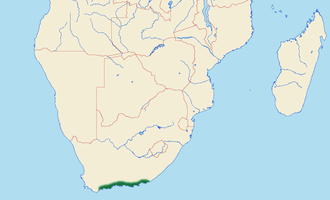Knysnaspecht
| Knysnaspecht | ||||||||||||
|---|---|---|---|---|---|---|---|---|---|---|---|---|
| Systematics | ||||||||||||
|
||||||||||||
| Scientific name | ||||||||||||
| Campethera notata | ||||||||||||
| ( Lichtenstein , 1823) |
The Knysna Woodpecker ( Campethera notata ) is a Spechtart from the genus of campethera ( Campethera ) in the subfamily of the Real woodpecker (Picinae). The little woodpecker is found in a narrow, coastal area in southernmost Africa. Some authors consider it a subspecies of the golden-tailed woodpecker ( Campethera abingoni ). Subspecies are not described. Due to the very small distribution area and the small population, the species is listed in the IUCN's warning list (NT = near threatened) . The name Knysna comes from the language of the Khoikhoi , an indigenous people of South Africa. He refers to the abundance of trees in this region.
Appearance
With a maximum body length of 22 centimeters, the Knysnaspecht is a small woodpecker, comparable in size to the domestic medium- sized woodpecker . Its weight is about 60 grams. In the field, the woodpecker looks quite dark, especially with worn plumage.
Neck and back are finely yellowish-white dashed on an olive-colored to yellow-greenish background, the more green-brownish wings are gently yellowish-white banded, whereby the width of the bands tapers from the inside out. The neck and the entire underside are speckled greenish-brown, shield-like, with a subdued whitish basic color. The support tail is olive green on the upper side and yellowish on the underside. A multiple, narrow, yellowish banding is clearly visible on its upper side, while it is indistinct on the lower side. Feet and four toes are greenish gray. On a dirty white ground, the cheeks are first finely darkly dashed from the base of the beak and are flaky dark olive towards the neck. The eyes are reddish in adult birds and dark in juvenile birds. The beak is dark gray. The male wears a relatively broad, brick-red head plate that extends to the neck and a strip of malar of the same color . The malar streak is missing in the female and the red head markings are limited to the back of the head. The skull is blackish and brightly dotted with lines. There are no further gender differences in color, size and weight. Fledglings resemble colored females in both sexes, but are overall greener on the upper side and more clearly spotted on the underside.
The individual variation is relatively large. Occasionally, very dark and intensely spotted individuals appear.
voice
The most common call is a whistling Wli-ii or Piiieh . In addition, threefold wiih-wi-wie sequences and almost crowing-sounding series of calls can often be heard.
distribution and habitat
The Knysnaspecht lives on a very narrow coastal strip in the Cape region of southernmost Africa. The westernmost occurrences are in the Swellendam area , the easternmost in the southeasternmost Natal . There its occurrence is limited to the coastal area, further into the hinterland the species only penetrates along streams and rivers. In some regions, the distribution areas of the Knysnaspechts and the closely related golden-tailed woodpecker touch each other . Hybridizations have not yet been reported.
The species inhabits open forests of different tree compositions, often also evergreen trees. In addition, it occurs in dense bush areas and largely open landscapes, as long as cave trees are available there. Occasionally it can also appear in parks and larger gardens. The species is not rare regionally.
Food and subsistence
Knysna woodpeckers feed primarily on ants and their stages of development. They also prey on wood-dwelling beetles and their larvae. They primarily look for food on dead or damaged branches and trunks. Usually they collect from the surface or poke in cracks and crevices. Lichen-covered tree sections appear to be particularly attractive.
Breeding biology
The species breeds between August and November, i.e. in southern spring. Both sexes build a nest box in dead wood. The clutch consists of 2–4 eggs. As far as is known, the incubation period is about twelve days, the nestling period is between three and four weeks. Both parents feed the nestlings with food that has been choked out.
Systematics
The Knysnaspecht is a member of the Spotted Woodpecker ( Campethera ), whose 12 representatives occur in Africa, mainly south of the equator. According to Winkler et al. it forms a super species with the very similar golden-tailed woodpecker ( Campethera abingoni ) and the Mombasaspecht ( Campethera mombassica ). Occasionally both species are considered to be subspecies of the golden-tailed woodpecker.
Existence and endangerment
The Knysnaspecht is listed by the IUCN in the warning list of endangered species. Although there are no analyzes of the population dynamics and the species is not rare regionally, this is justified with the relatively small distribution area of less than 50,000 square kilometers and the small total population of a maximum of 5000 animals. The felling of potential breeding trees seems to have a particularly negative effect on the population of the species. Large parts of the breeding area are increasingly being developed for tourism, which in addition to diverse disturbances also results in a not insignificant loss of habitat .
swell
literature
- Hans Winkler , David A. Christie and David Nurney: Woodpeckers. A Guide to the Woodpeckers, Piculets, and Wrynecks of the World. Pica Press, Robertsbridge 1995, ISBN 0-395-72043-5 , pp. 72-73 and 232-233.
Individual evidence
- ↑ Winkler et al. (1995) p. 232
- ↑ Birdlife pdf engl.
Web links
- BirdLife International , accessed January 15, 2010
- Campethera notata inthe IUCN 2013 Red List of Threatened Species . Listed by: BirdLife International, 2012. Retrieved February 6, 2014.

